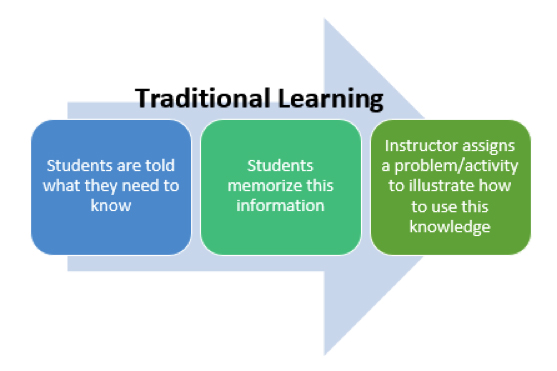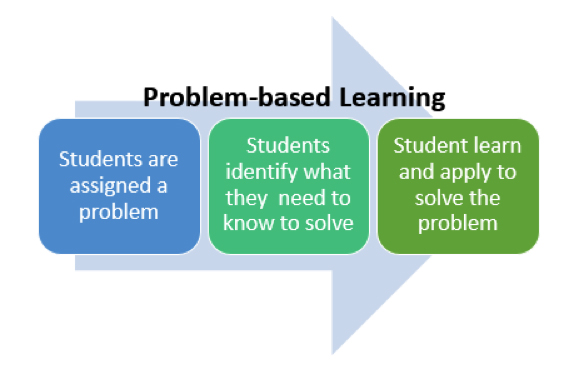Problem-based learning (PBL) is a student-centered pedagogy based on the constructivist learning theory through collaboration and self-directed learning. With PBL, students create knowledge and comprehension of a subject through the experience of solving an open-ended problem without a defined solution. Rather than focusing on learning problem-solving, PBL allows for the development of self-directed knowledge acquisition, along with enhanced teamwork and communication skills. Although originally developed for medical education, its use has expanded to other disciplines.
With PBL, the instructor’s role is to guide and challenge the learning process, rather than provide knowledge, while students engage in knowledge construction through teamwork. In alignment with constructivist theory, PBL promotes lifelong learning through inquiry.
Advantages:
- Student-centered learning;
- Promotes self-learning and self-motivation;
- Focuses on comprehension and higher level learning, rather than facts;
- Enhances critical appraisal skills;
- Develops literature retrieval and evaluation skills;
- Develops interpersonal skills and teamwork; and
- Promotes lifelong learning
Disadvantages:
- Instructor comfort with removing themselves from the central role;
- Student lack of acceptance of a different format of learning;
- Need for assessments that measure new knowledge and skills, such as practical exams, essays, peer and self assessments; and
- Time necessary to prepare course materials and assess
During the PBL process, students work in groups of 10-15 students supported by a tutor. The students are presented with a problem and, through group collaboration, activate their prior knowledge. The group develops hypotheses to explain the problem and identify issues to be researched which will help them to construct a shared explanation of the problem. After the initial teamwork, students work independently to research the identified issues, followed by discussion with the group about their findings and creation of a final explanation of the problem based on what they learned. The cycle can be repeated as needed.
The seven steps in the Maastricht PBL process are:
- Discuss the case to ensure everyone understands the problem;
- Identify questions in need of answers to fully understand the problem;
- Brainstorm what prior knowledge the group already has and identify potential solutions;
- Analyze and structure the findings from the brainstorming session;
- Formulate learning objectives for any lacking knowledge;
- Independently, research the information necessary to achieve the learning objectives defined as a group; and
- Discuss the findings with the group to develop a collective explanation of the problem.
In PBL learning, students in the group all serve a role. The roles should alternate through students for different problems. The tutor role is typically held by a instructor or teaching assistant who facilitates learning.
Tutor
- Facilitates learning by supporting and guiding;
- Monitors the learning process
- Aims to build students' confidence
- Checks group understanding
- Assesses performance
- Encourages all group members to participate
- Keeps group on topic
- Assists with group dynamics
- Assists with time keeping
- Ensures records kept by scribe are accurate
Chair
- Leads group through process
- Ensures group remains on topic
- Encourages members to participate
- Maintains group dynamics
- Keeps time
- Ensures scribe can keep up with accurate documentation
Scribe
- Leads group through process
- Ensures group remains on topic
- Encourages members to participate
- Maintains group dynamics
- Keeps time
- Ensures scribe can keep up with accurate documentation
Group Member
- Leads group through process
- Ensures group remains on topic
- Encourages members to participate
- Maintains group dynamics
- Keeps time
- Ensures scribe can keep up with accurate documentation
References and Resources:
Duch, Barbara J.; Groh, Susan; Allen, Deborah E. (2001). The power of problem-based learning : a practical "how to" for teaching undergraduate courses in any discipline (1st ed.). Sterling, VA: Stylus Pub.
Schmidt, Henk G; Rotgans, Jerome I; Yew, Elaine HJ (2011). "The process of problem-based learning: What works and why". Medical Education. 45 (8): 792–806.
Wood, D. F. (2003). "ABC of learning and teaching in medicine: Problem based learning"
Quick Links
![]()
Consult with our CETL Professionals
Consultation services are available to all UConn faculty at all campuses at no charge.

